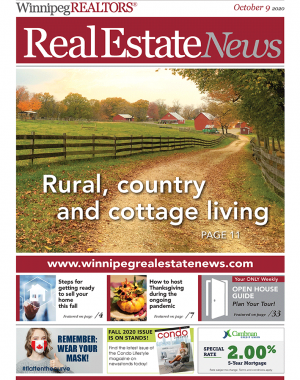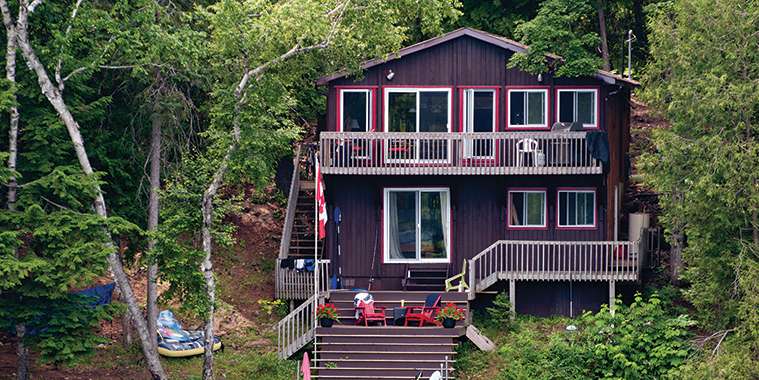The COVID-19 lockdown has presented us with an opportunity to reflect on what we need most in our living space.
Whether you suddenly found yourself wishing for a home office to work from remotely or simply a weekend getaway destination with ample outdoor space, many of us are now discovering that our current spaces don’t meet our needs in the same way as they did pre-pandemic.
For some current and prospective homeowners, the answer to what’s missing lies in cottage country.
Since the start of the real estate market’s early summer recovery, the cottage country market has been flourishing. A combination of fewer homes listed for sale and a surge in city buyers looking for rural properties has made this year one of the busiest in recent memory.
“This is the speediest, hottest market in [our] history. It’s never been like this before,” said Catharine Inniss, a Muskoka-based sales representative. “And it’s always been good. We’ve had a few dips here and there but not much.”
In July, real estate activity continued to rebound following massive declines in March and April, posting a 26% month-over-month increase in national sales. While inventory was also up Canada-wide, with the number of listed properties jumping 7.6% from June to July, Inniss explains that inventory in the Muskoka region has been low relative to the high demand from buyers this year.
In Manitoba, there have been 20% more resort property sales this year compared to last year for the first nine months. These 129 sales do not tell the entire story as there have been many other properties in rural resort areas that are selling this year in record numbers. For example, many of the 625 vacant lots which sold this year are in resort-locations and are ideal to build a cottage or even a four-season home. Vacant lot sales for the first nine months are up 57% over the same
period in 2019.
Clearly, Manitobans this year are looking at resort destinations to find their escape from the city and enjoy their lake country and the beauty and tranquility that goes with it.
When it comes to the type of buyers flooding the Muskoka market, for
example, Inniss says that it’s a mix of everyone — from millennials looking to break into the property market for the first time to boomer buyers. Budgets range widely too, starting anywhere from $400,000 to as high as $5 million and more.
In fact, one property in Manitoba located 15 minutes from Falcon Lake — that was listed for $799,000 — sold in September for over $1 million, well above list price. This is an example of the interest and committment we are seeing in rural, resort-like properties this year that we did not see anywhere near to the same extent in 2019.
As many companies downsize or eliminate their offices and rely more heavily on remote working arrangements, Inniss says clients are seeking the extra space that rural and cottage homes provide. City-based buyers may choose to rent in the city and purchase up north where real estate is often more affordable. For those buyers who frequently take vacation time, Inniss says they tend to put their travelling budget toward a downpayment.
“So before it was more talk and the idea, ‘That’d be wonderful,’ and now, a lot of employers have sort of stepped over that barrier because of the pandemic and are no longer concerned about people telecommuting,” said Inniss. “If you buy a [rural] property, you can extend your weekends, kind of come and go during non-rush hours, and I’m finding that clients are doing that a fair bit.”
Cottage country buyers are typically more serious about making a purchase when they drive up for a showing. Thanks to the growing emphasis of digital tools and virtual and livestream tours and viewings during the height of the pandemic, Inniss says there’s more information out there now to inform buyers about a property prior to seeing it in person. When buyers come for their scheduled visit, Inniss says it’s mostly to get a final feel for the home.
“It’s not like it used to be where you’d come up over and over and over again and then look,” she said. “They are coming to confirm what they’ve seen is actually in existence, it just has the feel that they’re looking for.”
Waterfront properties, given their limited supply, have been a particularly hot commodity in cottage country. The market for private islands has also seen a spike in demand this year, too. Inniss says she typically doesn’t sell any, but has made deals on five islands so far this year.
Winterized homes, which are outfitted with the appropriate plumbing and heating for all-season living, are sought after in today’s market as well, given their ability to allow urbanites the opportunity to live out of the city full-time if they choose to.
“Most buyers want four seasons so that they have the flexibility of being able to come year-round, maybe end up living here full-time,” says Inniss.
While the fall market typically slows down a little bit, Inniss says the late start to the season and the demand from buyers year-round will likely keep the momentum going. Additional inventory is expected to appear in the fall, she says, anticipating more sellers will decide to list their property a year earlier than planned.
If you’re looking to make the transition to cottage country, whether it be on a full-time or semi-permanent basis, Inniss stresses the importance of working with a local REALTOR® who lives and works in the area. They will be able to educate you on the unique traits that come with rural and waterfront living, from septic tanks to private roads and water quality.
— Realtor.ca



